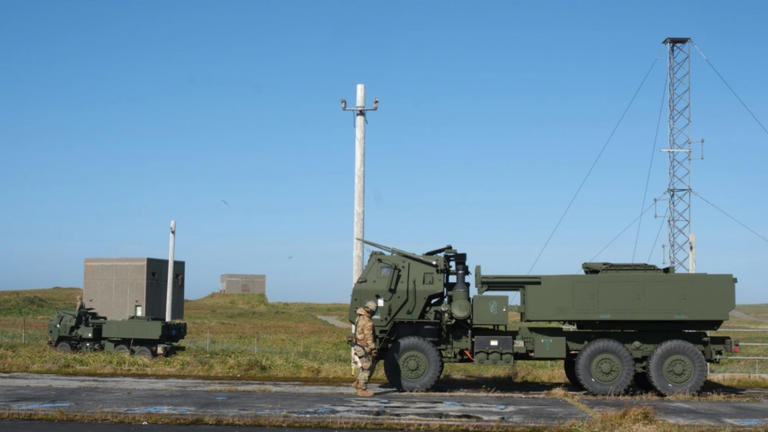U.S. Soldiers with Alpha Battery, 5th Battalion, 3rd Field Artillery Regiment (Long Range Fires Battalion), 1st Multi-Domain Task Force set up a M142 High Mobility Artillery Rocket System on Shemya Island on September 12, 2024. ARMY SPC. BRANDON VASQUEZ/U.S. ARMY
THE WATCH STAFF
The U.S. Army deployed paratroopers, radar operators and at least one M142 High Mobility Artillery Rocket System (HIMARS) to Shemya Island in the Aleutian Islands chain in September 2024 to monitor a combined People’s Republic of China (PRC)-Russia exercise nearby. The quick response highlighted the mobility and readiness of U.S. forces and their ability to respond rapidly to any potential threat.
The Alaska deployment on September 12 included troops with the 11th Airborne Division and the 1st and 3rd Multi-Domain Task Forces. The Air Force, along with the Alaska Air National Guard’s 176th Wing, transported the troops to Shemya, where they quickly set up the HIMARS system and Q-53 radars on the coastline. They took defensive positions around the island, which lies in the cluster of the Aleutians closest to Russia, according to Task & Purpose, a military affairs magazine.
The operation was partially in response to recent fly-bys by Russian aircraft and PRC bomber patrols in the Pacific Ocean. On September 14, just days after the U.S. deployment, the North American Aerospace Defense Command (NORAD) tracked two Russian IL-38 maritime patrol and anti-submarine aircraft operating in the Alaska Air Defense Identification Zone (ADIZ). The Russian aircraft didn’t enter United States or Canadian airspace and were not perceived as a threat, according to a NORAD news release. In July, four bombers entered the ADIZ, prompting the U.S. and Canada to send six fighter jets, including U.S. F-35s and F-16s plus Canadian CF-18s to intercept two Russian TU-95 warplanes and two PRC H-6 aircraft.
Part of that exercise — eight Russian planes and four naval vessels, including submarines — has approached U.S. airspace and waters but has not breached any sovereign boundary, The Associated Press reported. “It’s not the first time that we’ve seen the Russians and the Chinese flying, you know, in the vicinity, and that’s something that we obviously closely monitor, and it’s also something that we’re prepared to respond to,” Pentagon spokesman Maj. Gen. Pat Ryder said at a news conference.
The Shemya operation sends a clear message to strategic competitors, U.S. military officials said. “As the number of adversarial exercises increases around Alaska and throughout the region, including (the) joint Russian-Chinese bomber patrol, the operation to Shemya Island demonstrates the division’s ability to respond to events in the Indo-Pacific or across the globe, with a ready, lethal force within hours,” 11th Airborne Division commander Maj. Gen. Joseph Hilbert said in a statement.

